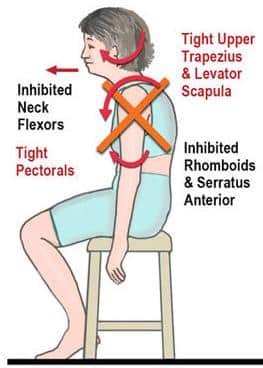Between the mid-back and armpit there are nerves and blood vessels that send signals and necessary blood flow which allow for proper movement of the lower neck, arms, and hands. Thoracic outlet syndrome is a condition in which these nerves and blood vessels in the lower neck are restricted, disrupting normal nerve signals and blood vessel function. People with Thoracic outlet syndrome experience discomfort and regular neck pain, back pain, numbness in the arm and weakness of the hand.
Thoracic Outlet Syndrome

What is Thoracic Outlet Syndrome?
What Causes It?
Compression of the nerves and blood vessels on the lower neck hinders lower neck, back, arm and normal finger movements and may cause occasional swelling, numbness in the arm, and coldness of the hand. Thoracic outlet syndrome occurs due to a combination of different factors:
- Poor posture (forward head and elevated shoulders).
- Repetitive arm strain
- Trauma
- Pregnancy
- Tumors
Anatomical defects normally occur at birth but are only detected much later in adult life.
Symptoms
Typically, patients manifest two or more symptoms:
- Neck pain
- Back pain
- Numbness in the arm
- Weakness of the arm
- Altered sensation and temperature in the arm
Common Types
The most frequently diagnosed type of Thoracic Outlet Syndrome by Neurologists and Orthopaedic Surgeons is ‘Neurogenic’. The three main types of Thoracic Outlet Syndrome, are:
- Neurogenic syndrome
- Venous syndrome
- Arterial syndrome
Suppression of the nerves and blood vessels which results in back pain, neck pain, weakness of the hand, and numbness in arm is linked to the Neurogenic Syndrome. Swelling and pain of hand and arm are linked to the Venous Syndrome, and lastly, pain, coldness, and discoloring of the hand are diagnosed as the Arterial Outlet Syndrome.
Treatment
If you experience neck pain at the side of your neck, coldness in one hand and not the other and swelling of the arm, you need to see a Physiotherapist, Chiropractor or Doctor.
Once diagnosed, the recommended healing remedies are:
Physical exercise
Medication
Surgery
The commonly used treatment of the three is physical exercise as it is known that poor body postures during activity or work is a large contributing factor. Recommended therapies include posture education, remedial massage, chiropractic adjustments, acupuncture, stretching and strengthening based exercise programs. Back and neck pain relief medications may also be prescribed by your doctor. In extreme conditions surgery may be recommended to remove a cervical rib.

Prevention
Patients who mostly suffer from this syndrome have a job where they sit for prolonged periods, exposed to high stress levels and are not taking recommended breaks to stretch their neck and arms. Athletes who repeatedly use arms above their heads such and swimmers, basketball, volleyball players to name a few, may suffer from Thoracic Outlet Syndrome also.
Regular stretching and core strengthening exercises help maintain good back posture. Taking regular breaks to exercise the neck and stretch the arm to allow normal blood flow is of utmost importance.
Before exercising, warm your muscles by taking a walk or walking up and down a stairway in an upright position. Stretch the neck, arms, hands, and fingers holding for 20 to 30 seconds in a particular position. Repeat the stretch exercise as desired between work intervals. Remember to use an ergonomic chair or use a lumbar roll that will support your spine, so you do not hunch forward and aggravate the lower neck muscles, nerves and blood vessels that will lead to neck pain, back pain, numbness in the arm and weakness of the hand.
Getting Better
Your Doctor or Physiotherapist will recommend the best treatment method for you after a careful assessment of your condition.
Physical exercise will require that a patient properly acquaints themselves with the exercise routines and carries them out as accurately as possible. Medication in the form of prescription drugs for pain, numbness in the arm, and swelling may have to be taken over a period to reverse the condition. If exercise and medication do not address the condition, the patient may undergo surgery. After surgery, the recovery period is a minimum of 6 months.
Patients with Thoracic Outlet Syndrome need to regularly be conscious of their posture and be dedicated to living an active lifestyle to ensure they recover fully!

New Client Offer - 10% OFF
Are you in pain? Not sure if we can help you?
Book your initial appointment and receive 10% off any service!